Computer Information System: Big Data Analytics Report
VerifiedAdded on 2022/10/12
|8
|1586
|329
Report
AI Summary
This report provides a comprehensive analysis of big data analytics, focusing on its application within a retail business context. It begins by identifying appropriate technologies like IBM Db2 and Oracle Database 12c, along with necessary IoT devices such as retail websites, mobile apps, and servers. The report outlines specific goals and objectives, emphasizing the use of big data for enhanced customer insights, targeted marketing, and improved decision-making. A SWOT analysis is conducted to evaluate the strengths, weaknesses, opportunities, and threats associated with the chosen technologies and their integration into the existing infrastructure. The report also addresses critical implementation and integration issues, including data growth, timely insights generation, talent acquisition, data integration challenges, data validation, and security concerns. Furthermore, it explores people, process, and governance issues, highlighting the importance of organizational change management and data governance for successful big data initiatives. References to relevant reports and surveys are included to support the analysis.
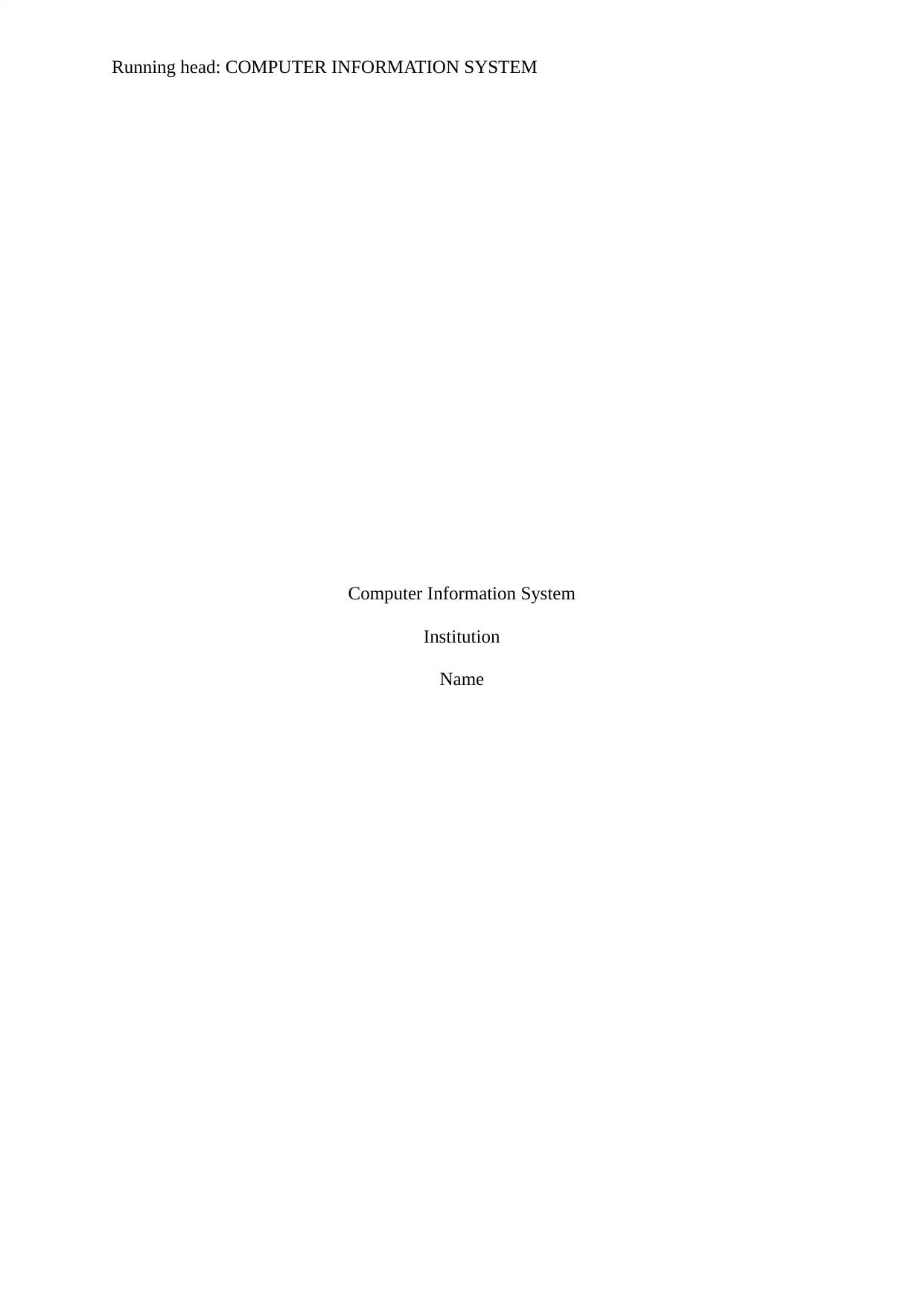
Running head: COMPUTER INFORMATION SYSTEM
Computer Information System
Institution
Name
Computer Information System
Institution
Name
Paraphrase This Document
Need a fresh take? Get an instant paraphrase of this document with our AI Paraphraser
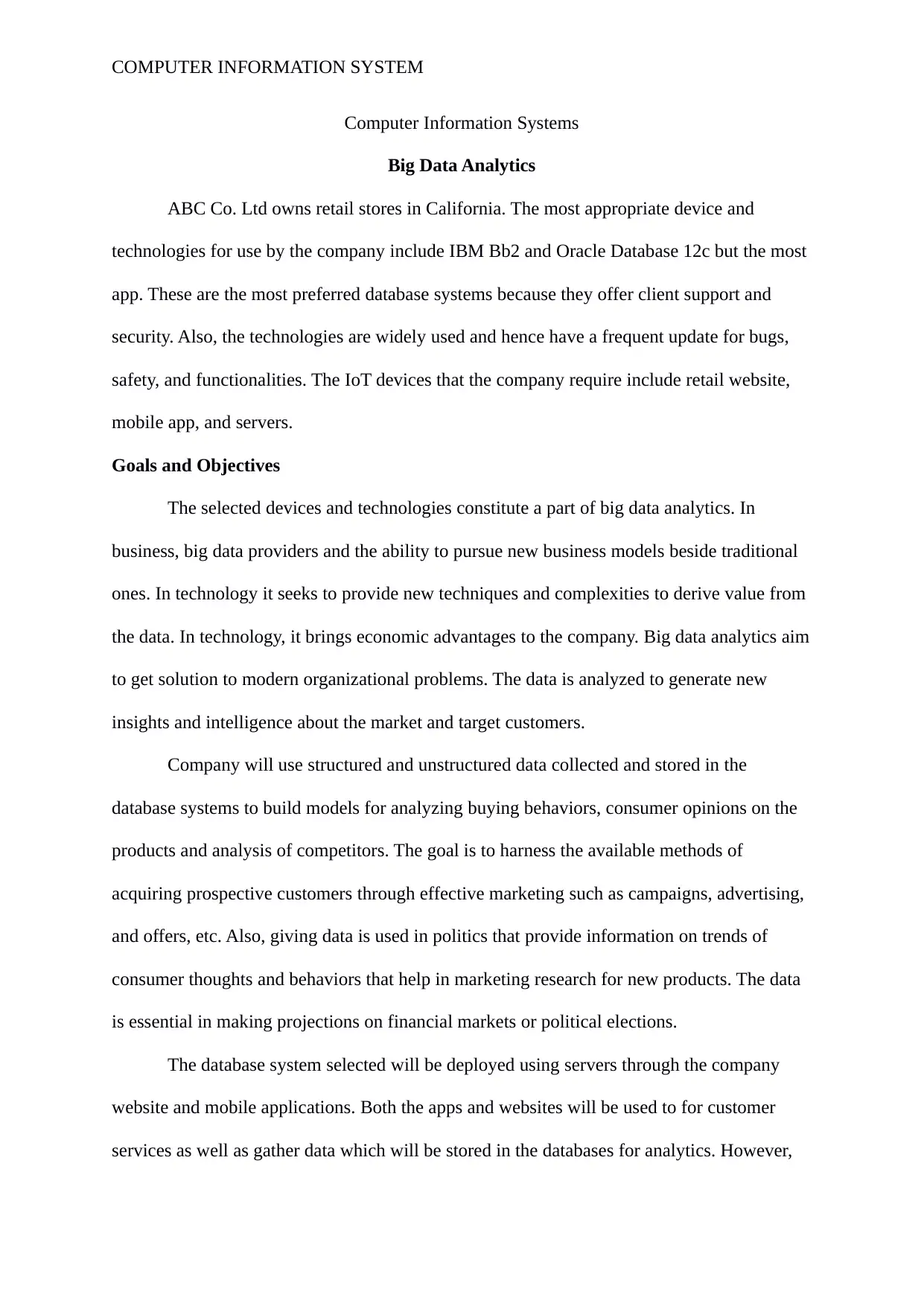
COMPUTER INFORMATION SYSTEM
Computer Information Systems
Big Data Analytics
ABC Co. Ltd owns retail stores in California. The most appropriate device and
technologies for use by the company include IBM Bb2 and Oracle Database 12c but the most
app. These are the most preferred database systems because they offer client support and
security. Also, the technologies are widely used and hence have a frequent update for bugs,
safety, and functionalities. The IoT devices that the company require include retail website,
mobile app, and servers.
Goals and Objectives
The selected devices and technologies constitute a part of big data analytics. In
business, big data providers and the ability to pursue new business models beside traditional
ones. In technology it seeks to provide new techniques and complexities to derive value from
the data. In technology, it brings economic advantages to the company. Big data analytics aim
to get solution to modern organizational problems. The data is analyzed to generate new
insights and intelligence about the market and target customers.
Company will use structured and unstructured data collected and stored in the
database systems to build models for analyzing buying behaviors, consumer opinions on the
products and analysis of competitors. The goal is to harness the available methods of
acquiring prospective customers through effective marketing such as campaigns, advertising,
and offers, etc. Also, giving data is used in politics that provide information on trends of
consumer thoughts and behaviors that help in marketing research for new products. The data
is essential in making projections on financial markets or political elections.
The database system selected will be deployed using servers through the company
website and mobile applications. Both the apps and websites will be used to for customer
services as well as gather data which will be stored in the databases for analytics. However,
Computer Information Systems
Big Data Analytics
ABC Co. Ltd owns retail stores in California. The most appropriate device and
technologies for use by the company include IBM Bb2 and Oracle Database 12c but the most
app. These are the most preferred database systems because they offer client support and
security. Also, the technologies are widely used and hence have a frequent update for bugs,
safety, and functionalities. The IoT devices that the company require include retail website,
mobile app, and servers.
Goals and Objectives
The selected devices and technologies constitute a part of big data analytics. In
business, big data providers and the ability to pursue new business models beside traditional
ones. In technology it seeks to provide new techniques and complexities to derive value from
the data. In technology, it brings economic advantages to the company. Big data analytics aim
to get solution to modern organizational problems. The data is analyzed to generate new
insights and intelligence about the market and target customers.
Company will use structured and unstructured data collected and stored in the
database systems to build models for analyzing buying behaviors, consumer opinions on the
products and analysis of competitors. The goal is to harness the available methods of
acquiring prospective customers through effective marketing such as campaigns, advertising,
and offers, etc. Also, giving data is used in politics that provide information on trends of
consumer thoughts and behaviors that help in marketing research for new products. The data
is essential in making projections on financial markets or political elections.
The database system selected will be deployed using servers through the company
website and mobile applications. Both the apps and websites will be used to for customer
services as well as gather data which will be stored in the databases for analytics. However,
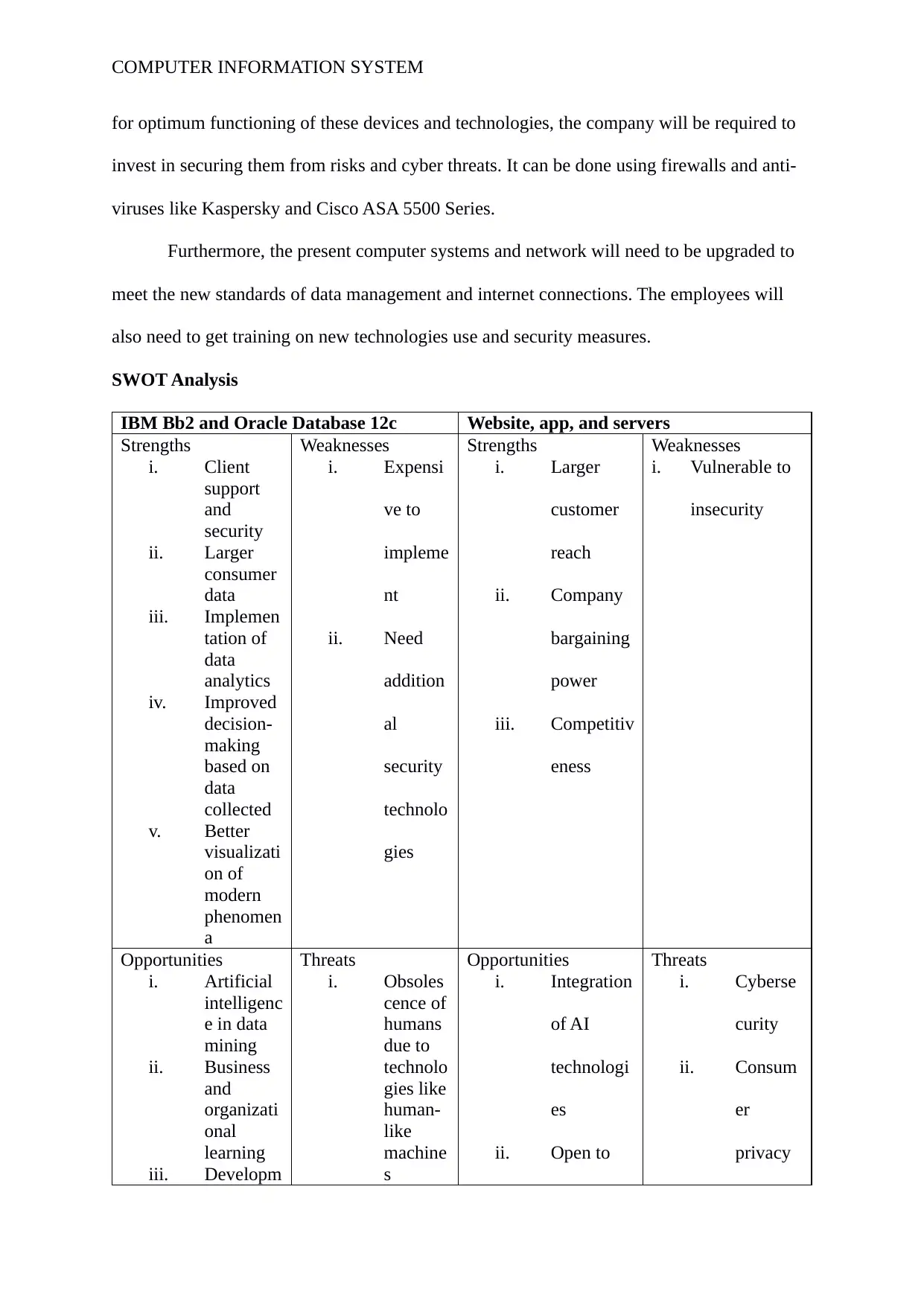
COMPUTER INFORMATION SYSTEM
for optimum functioning of these devices and technologies, the company will be required to
invest in securing them from risks and cyber threats. It can be done using firewalls and anti-
viruses like Kaspersky and Cisco ASA 5500 Series.
Furthermore, the present computer systems and network will need to be upgraded to
meet the new standards of data management and internet connections. The employees will
also need to get training on new technologies use and security measures.
SWOT Analysis
IBM Bb2 and Oracle Database 12c Website, app, and servers
Strengths
i. Client
support
and
security
ii. Larger
consumer
data
iii. Implemen
tation of
data
analytics
iv. Improved
decision-
making
based on
data
collected
v. Better
visualizati
on of
modern
phenomen
a
Weaknesses
i. Expensi
ve to
impleme
nt
ii. Need
addition
al
security
technolo
gies
Strengths
i. Larger
customer
reach
ii. Company
bargaining
power
iii. Competitiv
eness
Weaknesses
i. Vulnerable to
insecurity
Opportunities
i. Artificial
intelligenc
e in data
mining
ii. Business
and
organizati
onal
learning
iii. Developm
Threats
i. Obsoles
cence of
humans
due to
technolo
gies like
human-
like
machine
s
Opportunities
i. Integration
of AI
technologi
es
ii. Open to
Threats
i. Cyberse
curity
ii. Consum
er
privacy
for optimum functioning of these devices and technologies, the company will be required to
invest in securing them from risks and cyber threats. It can be done using firewalls and anti-
viruses like Kaspersky and Cisco ASA 5500 Series.
Furthermore, the present computer systems and network will need to be upgraded to
meet the new standards of data management and internet connections. The employees will
also need to get training on new technologies use and security measures.
SWOT Analysis
IBM Bb2 and Oracle Database 12c Website, app, and servers
Strengths
i. Client
support
and
security
ii. Larger
consumer
data
iii. Implemen
tation of
data
analytics
iv. Improved
decision-
making
based on
data
collected
v. Better
visualizati
on of
modern
phenomen
a
Weaknesses
i. Expensi
ve to
impleme
nt
ii. Need
addition
al
security
technolo
gies
Strengths
i. Larger
customer
reach
ii. Company
bargaining
power
iii. Competitiv
eness
Weaknesses
i. Vulnerable to
insecurity
Opportunities
i. Artificial
intelligenc
e in data
mining
ii. Business
and
organizati
onal
learning
iii. Developm
Threats
i. Obsoles
cence of
humans
due to
technolo
gies like
human-
like
machine
s
Opportunities
i. Integration
of AI
technologi
es
ii. Open to
Threats
i. Cyberse
curity
ii. Consum
er
privacy
⊘ This is a preview!⊘
Do you want full access?
Subscribe today to unlock all pages.

Trusted by 1+ million students worldwide
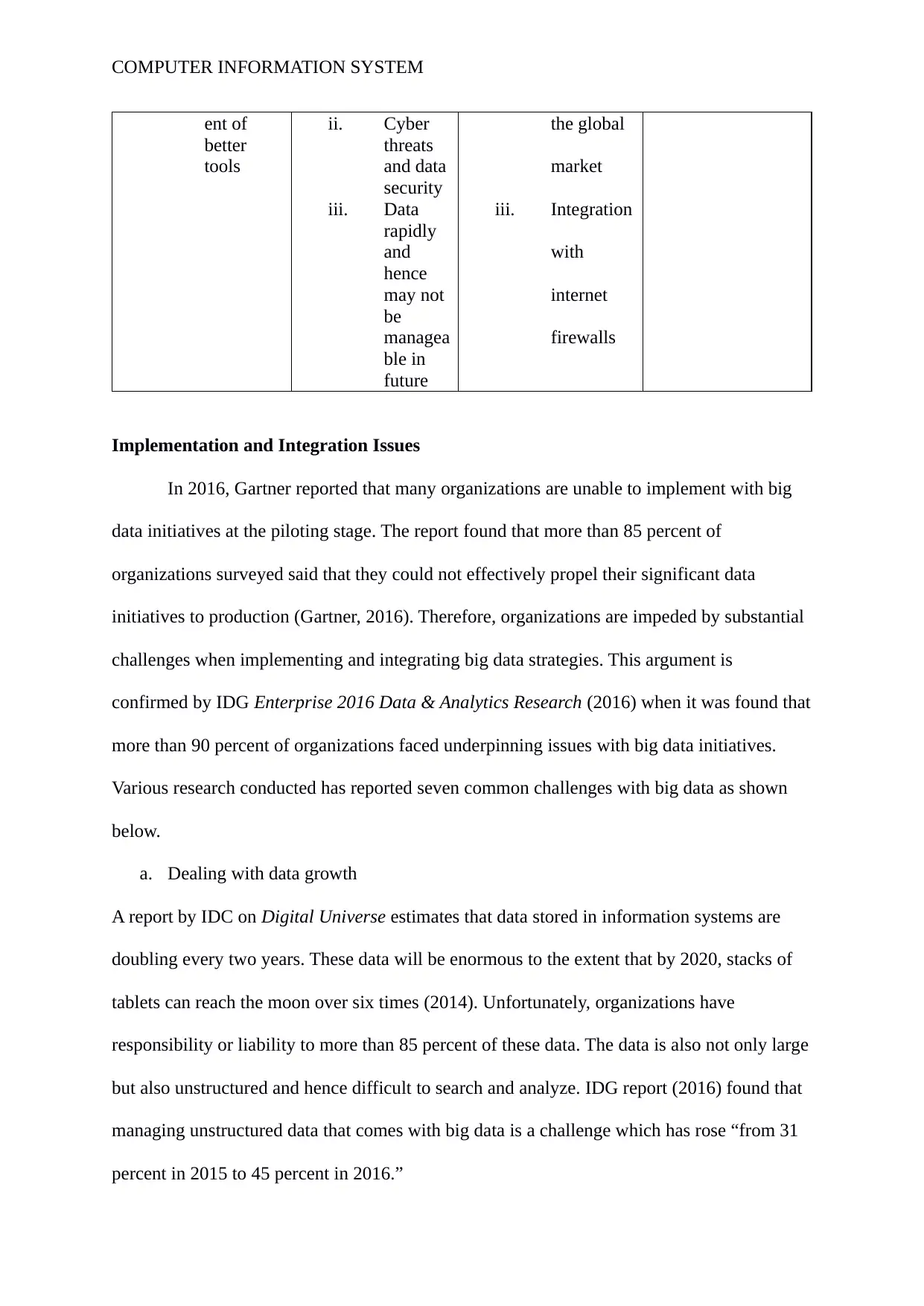
COMPUTER INFORMATION SYSTEM
ent of
better
tools
ii. Cyber
threats
and data
security
iii. Data
rapidly
and
hence
may not
be
managea
ble in
future
the global
market
iii. Integration
with
internet
firewalls
Implementation and Integration Issues
In 2016, Gartner reported that many organizations are unable to implement with big
data initiatives at the piloting stage. The report found that more than 85 percent of
organizations surveyed said that they could not effectively propel their significant data
initiatives to production (Gartner, 2016). Therefore, organizations are impeded by substantial
challenges when implementing and integrating big data strategies. This argument is
confirmed by IDG Enterprise 2016 Data & Analytics Research (2016) when it was found that
more than 90 percent of organizations faced underpinning issues with big data initiatives.
Various research conducted has reported seven common challenges with big data as shown
below.
a. Dealing with data growth
A report by IDC on Digital Universe estimates that data stored in information systems are
doubling every two years. These data will be enormous to the extent that by 2020, stacks of
tablets can reach the moon over six times (2014). Unfortunately, organizations have
responsibility or liability to more than 85 percent of these data. The data is also not only large
but also unstructured and hence difficult to search and analyze. IDG report (2016) found that
managing unstructured data that comes with big data is a challenge which has rose “from 31
percent in 2015 to 45 percent in 2016.”
ent of
better
tools
ii. Cyber
threats
and data
security
iii. Data
rapidly
and
hence
may not
be
managea
ble in
future
the global
market
iii. Integration
with
internet
firewalls
Implementation and Integration Issues
In 2016, Gartner reported that many organizations are unable to implement with big
data initiatives at the piloting stage. The report found that more than 85 percent of
organizations surveyed said that they could not effectively propel their significant data
initiatives to production (Gartner, 2016). Therefore, organizations are impeded by substantial
challenges when implementing and integrating big data strategies. This argument is
confirmed by IDG Enterprise 2016 Data & Analytics Research (2016) when it was found that
more than 90 percent of organizations faced underpinning issues with big data initiatives.
Various research conducted has reported seven common challenges with big data as shown
below.
a. Dealing with data growth
A report by IDC on Digital Universe estimates that data stored in information systems are
doubling every two years. These data will be enormous to the extent that by 2020, stacks of
tablets can reach the moon over six times (2014). Unfortunately, organizations have
responsibility or liability to more than 85 percent of these data. The data is also not only large
but also unstructured and hence difficult to search and analyze. IDG report (2016) found that
managing unstructured data that comes with big data is a challenge which has rose “from 31
percent in 2015 to 45 percent in 2016.”
Paraphrase This Document
Need a fresh take? Get an instant paraphrase of this document with our AI Paraphraser
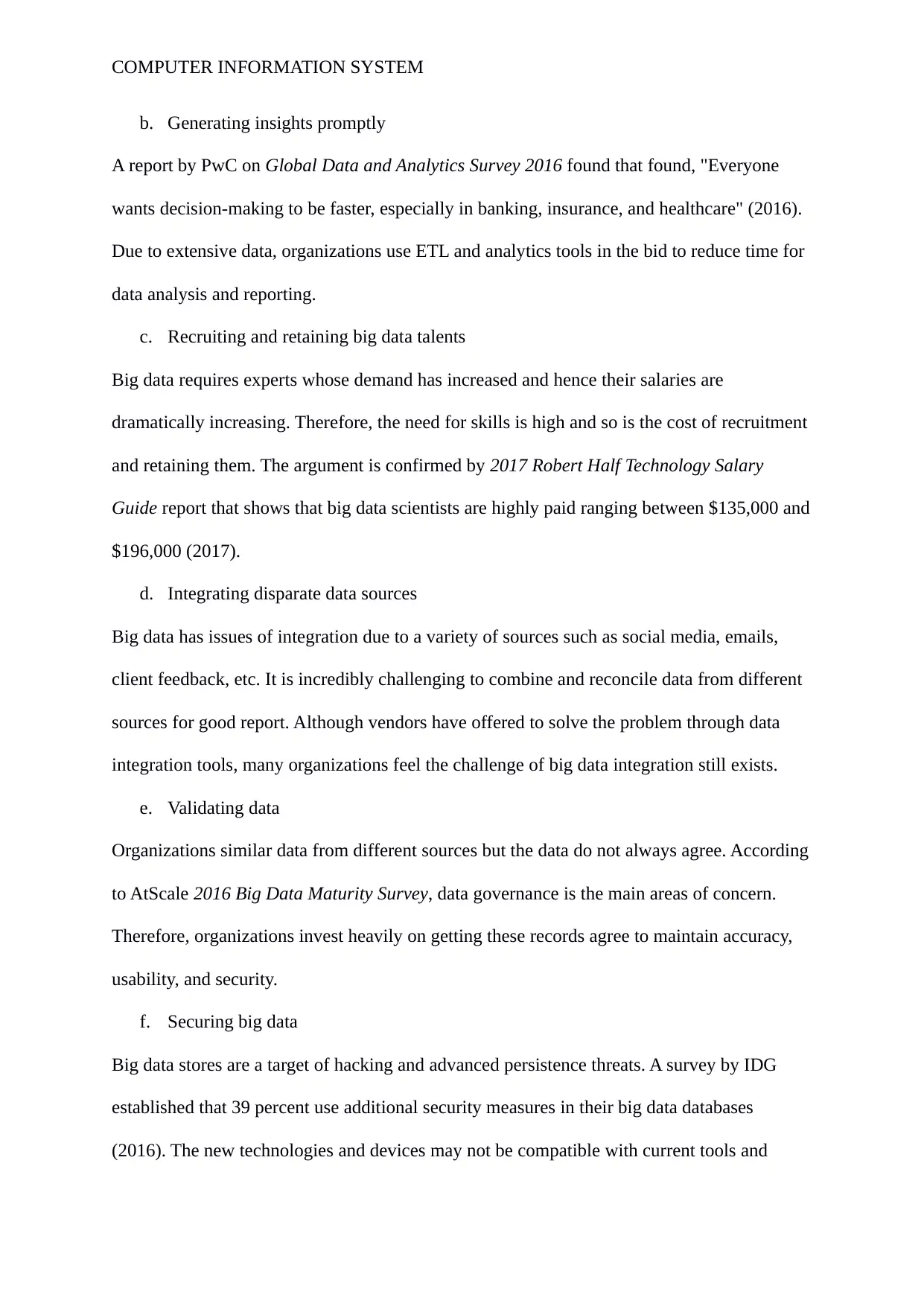
COMPUTER INFORMATION SYSTEM
b. Generating insights promptly
A report by PwC on Global Data and Analytics Survey 2016 found that found, "Everyone
wants decision-making to be faster, especially in banking, insurance, and healthcare" (2016).
Due to extensive data, organizations use ETL and analytics tools in the bid to reduce time for
data analysis and reporting.
c. Recruiting and retaining big data talents
Big data requires experts whose demand has increased and hence their salaries are
dramatically increasing. Therefore, the need for skills is high and so is the cost of recruitment
and retaining them. The argument is confirmed by 2017 Robert Half Technology Salary
Guide report that shows that big data scientists are highly paid ranging between $135,000 and
$196,000 (2017).
d. Integrating disparate data sources
Big data has issues of integration due to a variety of sources such as social media, emails,
client feedback, etc. It is incredibly challenging to combine and reconcile data from different
sources for good report. Although vendors have offered to solve the problem through data
integration tools, many organizations feel the challenge of big data integration still exists.
e. Validating data
Organizations similar data from different sources but the data do not always agree. According
to AtScale 2016 Big Data Maturity Survey, data governance is the main areas of concern.
Therefore, organizations invest heavily on getting these records agree to maintain accuracy,
usability, and security.
f. Securing big data
Big data stores are a target of hacking and advanced persistence threats. A survey by IDG
established that 39 percent use additional security measures in their big data databases
(2016). The new technologies and devices may not be compatible with current tools and
b. Generating insights promptly
A report by PwC on Global Data and Analytics Survey 2016 found that found, "Everyone
wants decision-making to be faster, especially in banking, insurance, and healthcare" (2016).
Due to extensive data, organizations use ETL and analytics tools in the bid to reduce time for
data analysis and reporting.
c. Recruiting and retaining big data talents
Big data requires experts whose demand has increased and hence their salaries are
dramatically increasing. Therefore, the need for skills is high and so is the cost of recruitment
and retaining them. The argument is confirmed by 2017 Robert Half Technology Salary
Guide report that shows that big data scientists are highly paid ranging between $135,000 and
$196,000 (2017).
d. Integrating disparate data sources
Big data has issues of integration due to a variety of sources such as social media, emails,
client feedback, etc. It is incredibly challenging to combine and reconcile data from different
sources for good report. Although vendors have offered to solve the problem through data
integration tools, many organizations feel the challenge of big data integration still exists.
e. Validating data
Organizations similar data from different sources but the data do not always agree. According
to AtScale 2016 Big Data Maturity Survey, data governance is the main areas of concern.
Therefore, organizations invest heavily on getting these records agree to maintain accuracy,
usability, and security.
f. Securing big data
Big data stores are a target of hacking and advanced persistence threats. A survey by IDG
established that 39 percent use additional security measures in their big data databases
(2016). The new technologies and devices may not be compatible with current tools and
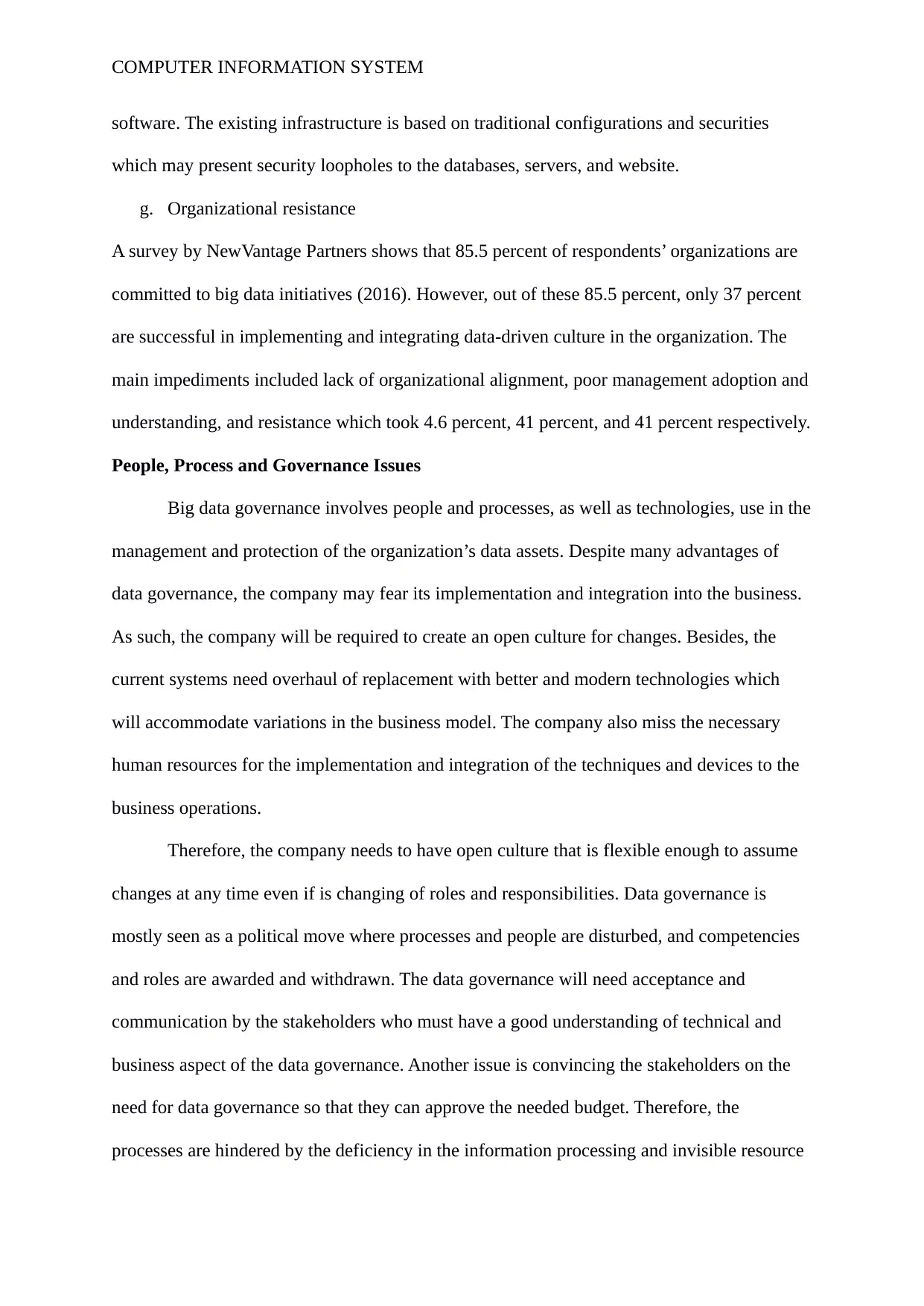
COMPUTER INFORMATION SYSTEM
software. The existing infrastructure is based on traditional configurations and securities
which may present security loopholes to the databases, servers, and website.
g. Organizational resistance
A survey by NewVantage Partners shows that 85.5 percent of respondents’ organizations are
committed to big data initiatives (2016). However, out of these 85.5 percent, only 37 percent
are successful in implementing and integrating data-driven culture in the organization. The
main impediments included lack of organizational alignment, poor management adoption and
understanding, and resistance which took 4.6 percent, 41 percent, and 41 percent respectively.
People, Process and Governance Issues
Big data governance involves people and processes, as well as technologies, use in the
management and protection of the organization’s data assets. Despite many advantages of
data governance, the company may fear its implementation and integration into the business.
As such, the company will be required to create an open culture for changes. Besides, the
current systems need overhaul of replacement with better and modern technologies which
will accommodate variations in the business model. The company also miss the necessary
human resources for the implementation and integration of the techniques and devices to the
business operations.
Therefore, the company needs to have open culture that is flexible enough to assume
changes at any time even if is changing of roles and responsibilities. Data governance is
mostly seen as a political move where processes and people are disturbed, and competencies
and roles are awarded and withdrawn. The data governance will need acceptance and
communication by the stakeholders who must have a good understanding of technical and
business aspect of the data governance. Another issue is convincing the stakeholders on the
need for data governance so that they can approve the needed budget. Therefore, the
processes are hindered by the deficiency in the information processing and invisible resource
software. The existing infrastructure is based on traditional configurations and securities
which may present security loopholes to the databases, servers, and website.
g. Organizational resistance
A survey by NewVantage Partners shows that 85.5 percent of respondents’ organizations are
committed to big data initiatives (2016). However, out of these 85.5 percent, only 37 percent
are successful in implementing and integrating data-driven culture in the organization. The
main impediments included lack of organizational alignment, poor management adoption and
understanding, and resistance which took 4.6 percent, 41 percent, and 41 percent respectively.
People, Process and Governance Issues
Big data governance involves people and processes, as well as technologies, use in the
management and protection of the organization’s data assets. Despite many advantages of
data governance, the company may fear its implementation and integration into the business.
As such, the company will be required to create an open culture for changes. Besides, the
current systems need overhaul of replacement with better and modern technologies which
will accommodate variations in the business model. The company also miss the necessary
human resources for the implementation and integration of the techniques and devices to the
business operations.
Therefore, the company needs to have open culture that is flexible enough to assume
changes at any time even if is changing of roles and responsibilities. Data governance is
mostly seen as a political move where processes and people are disturbed, and competencies
and roles are awarded and withdrawn. The data governance will need acceptance and
communication by the stakeholders who must have a good understanding of technical and
business aspect of the data governance. Another issue is convincing the stakeholders on the
need for data governance so that they can approve the needed budget. Therefore, the
processes are hindered by the deficiency in the information processing and invisible resource
⊘ This is a preview!⊘
Do you want full access?
Subscribe today to unlock all pages.

Trusted by 1+ million students worldwide

COMPUTER INFORMATION SYSTEM
needs of such programs.
needs of such programs.
Paraphrase This Document
Need a fresh take? Get an instant paraphrase of this document with our AI Paraphraser
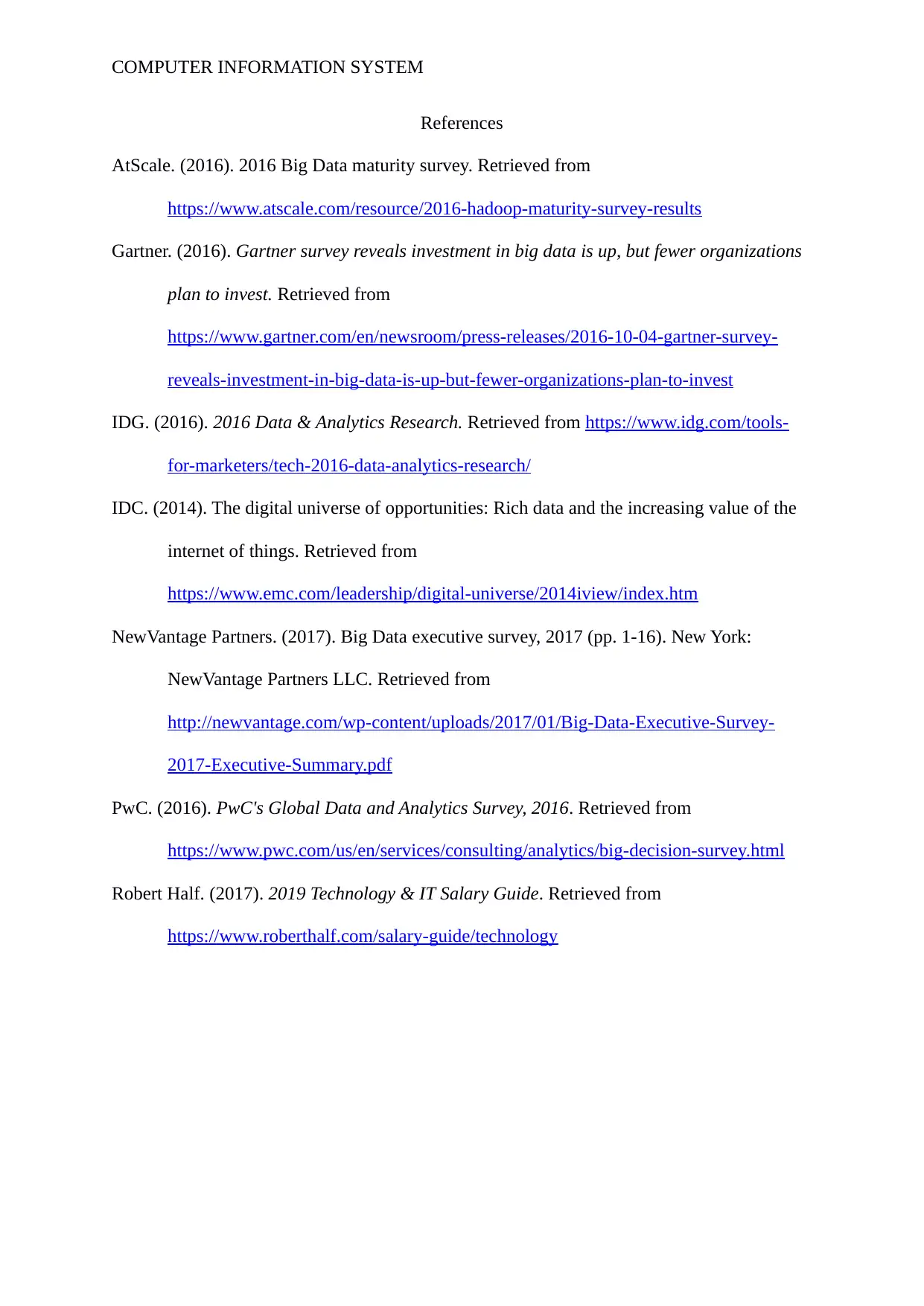
COMPUTER INFORMATION SYSTEM
References
AtScale. (2016). 2016 Big Data maturity survey. Retrieved from
https://www.atscale.com/resource/2016-hadoop-maturity-survey-results
Gartner. (2016). Gartner survey reveals investment in big data is up, but fewer organizations
plan to invest. Retrieved from
https://www.gartner.com/en/newsroom/press-releases/2016-10-04-gartner-survey-
reveals-investment-in-big-data-is-up-but-fewer-organizations-plan-to-invest
IDG. (2016). 2016 Data & Analytics Research. Retrieved from https://www.idg.com/tools-
for-marketers/tech-2016-data-analytics-research/
IDC. (2014). The digital universe of opportunities: Rich data and the increasing value of the
internet of things. Retrieved from
https://www.emc.com/leadership/digital-universe/2014iview/index.htm
NewVantage Partners. (2017). Big Data executive survey, 2017 (pp. 1-16). New York:
NewVantage Partners LLC. Retrieved from
http://newvantage.com/wp-content/uploads/2017/01/Big-Data-Executive-Survey-
2017-Executive-Summary.pdf
PwC. (2016). PwC's Global Data and Analytics Survey, 2016. Retrieved from
https://www.pwc.com/us/en/services/consulting/analytics/big-decision-survey.html
Robert Half. (2017). 2019 Technology & IT Salary Guide. Retrieved from
https://www.roberthalf.com/salary-guide/technology
References
AtScale. (2016). 2016 Big Data maturity survey. Retrieved from
https://www.atscale.com/resource/2016-hadoop-maturity-survey-results
Gartner. (2016). Gartner survey reveals investment in big data is up, but fewer organizations
plan to invest. Retrieved from
https://www.gartner.com/en/newsroom/press-releases/2016-10-04-gartner-survey-
reveals-investment-in-big-data-is-up-but-fewer-organizations-plan-to-invest
IDG. (2016). 2016 Data & Analytics Research. Retrieved from https://www.idg.com/tools-
for-marketers/tech-2016-data-analytics-research/
IDC. (2014). The digital universe of opportunities: Rich data and the increasing value of the
internet of things. Retrieved from
https://www.emc.com/leadership/digital-universe/2014iview/index.htm
NewVantage Partners. (2017). Big Data executive survey, 2017 (pp. 1-16). New York:
NewVantage Partners LLC. Retrieved from
http://newvantage.com/wp-content/uploads/2017/01/Big-Data-Executive-Survey-
2017-Executive-Summary.pdf
PwC. (2016). PwC's Global Data and Analytics Survey, 2016. Retrieved from
https://www.pwc.com/us/en/services/consulting/analytics/big-decision-survey.html
Robert Half. (2017). 2019 Technology & IT Salary Guide. Retrieved from
https://www.roberthalf.com/salary-guide/technology
1 out of 8
Related Documents
Your All-in-One AI-Powered Toolkit for Academic Success.
+13062052269
info@desklib.com
Available 24*7 on WhatsApp / Email
![[object Object]](/_next/static/media/star-bottom.7253800d.svg)
Unlock your academic potential
Copyright © 2020–2025 A2Z Services. All Rights Reserved. Developed and managed by ZUCOL.




